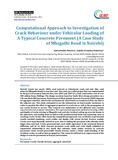| dc.contributor.author | Mwaura, Njiru Joseph | |
| dc.contributor.author | Mumenya, Siphila Wanjiku | |
| dc.date.accessioned | 2016-07-01T13:32:15Z | |
| dc.date.available | 2016-07-01T13:32:15Z | |
| dc.date.issued | 2015 | |
| dc.identifier.citation | ABC Research Alert Vol 3, Number 2/ 2015 | en_US |
| dc.identifier.issn | http://abcreal.weebly.com/ | |
| dc.identifier.uri | http://hdl.handle.net/11295/96707 | |
| dc.description.abstract | Nairobi County has nearly 100% road network as bituminous roads and only 4km road
network (Mbagathi Road) is concrete road. This road was a pilot project that was implemented
by Kenyan Government between the years 2005 and 2007 at a total construction cost of over
400 million Kenya Shillings. The design was done based on South Africa design procedure on a
210 mm thick PJCP pavement. Performance of Plain Jointed Concrete Pavement (PJCP) depends
on aggregate interlock, which is the mechanism by which loads are transferred from one slab to
the adjacent one. This study attempted to use the information on load transfer mechanics in
order to quantify the effect of aggregate properties to crack size as well as the propagation of
any cracks formed in service. This research was undertaken in two different ways namely
experimental and computer simulation. The experimental approach entailed measuring widths
and depths of cracks existing in Mbagathi road, and also involved setting up concrete beams in
the laboratory and loading them to failure with predetermined loads and measuring sizes of
resulting cracks. On the other hand, the computational approach was verified by experimental
results entailed simulating crack widths and depths with recent devised fracture models.
Cracks were experimentally noticed to occur due to loading the pavement with vehicular loads
bigger than safe load. Cracks generated had crack width equivalent to the measured flexural
deflection and for an ideal concrete pavement crack width and crack depth exhibited an
exponential relationship. It was found that vehicular loads induce stresses in concrete
pavements which exceed permissible tensile stresses, hence a better understanding of the
resultant cracks, as well as their propagation. This research will lead to an improvement of the
design of concrete pavements in Kenyan environment. | en_US |
| dc.language.iso | en | en_US |
| dc.rights | Attribution-NonCommercial-NoDerivs 3.0 United States | * |
| dc.rights.uri | http://creativecommons.org/licenses/by-nc-nd/3.0/us/ | * |
| dc.subject | Pavement | en_US |
| dc.subject | Cracks | en_US |
| dc.subject | Tensile stresses | en_US |
| dc.subject | Aggregate | en_US |
| dc.subject | Interlock | en_US |
| dc.title | Computational Approach to Investigation of Crack Behaviour under Vehicular Loading of A Typical Concrete Pavement (A Case Study of Mbagathi Road in Nairobi) | en_US |
| dc.type | Article | en_US |



